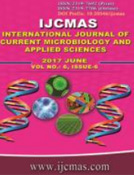


 National Academy of Agricultural Sciences (NAAS)
National Academy of Agricultural Sciences (NAAS)

|
PRINT ISSN : 2319-7692
Online ISSN : 2319-7706 Issues : 12 per year Publisher : Excellent Publishers Email : editorijcmas@gmail.com / submit@ijcmas.com Editor-in-chief: Dr.M.Prakash Index Copernicus ICV 2018: 95.39 NAAS RATING 2020: 5.38 |
DNA barcoding is a technique that makes use of short sequences from a standardized region of a genome to provide quick and reliable identification of species among all forms of life. The presence of uniqueness and variability required for DNA barcoding is well reported in animal system based on mitochondrial gene CO1.On the other hand, limited information is available on universal barcode for plants. Candidate loci belonging to chloroplast genome (CpG) and nuclear genome have been analyzed in various plants to identify universal barcoding loci capable of inter and intraspecies discrimination. In this study, relative potential of 24 candidate loci (Dong et al, 2012) from plastid genome were validated on set of 231 diverse rice genotypes, for selection of suitable barcoding loci for DNA barcoding in rice. Results indicated that only one of the chloroplast CGS primer pair “psbA-trnH” showed (100%) amplification efficiency followed by “rbcL” (89.61%), “atpH-atpl” (68.39%), “matK” (66.2%) and “petA-psbJ” (62.33%). While 9 primers showed lower amplification efficiency between 5.19% and 52.81%. Based on amplification efficiency, reproducibility and amplicon size (as per Consortium for the Barcode of Life standard) five primers were selected for amplicon sequencing and further study of phylogenetic and phylogeographical relationships among above genotypes.
 |
 |
 |
 |
 |